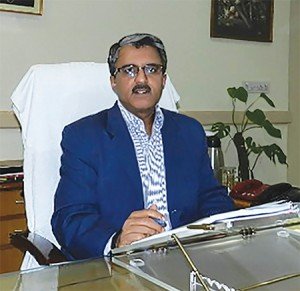 The Union government has drawn up an ambitious `25,000-crore plan to create a national waterway grid linking Ganga, Brahmputra, Mahanadi and Godavari rivers, giving an in-principle clearance to the eight-year project. In an exclusive interview with TrafficInfraTech, Pravir Pandey, Member (Finance), Inland Waterways Authority of India (IWAI) and Project Director, Jal Marg Vikas Project speaks about the challenges facing development of Inland Waterways in India and the IWAI’s plans for it.
The Union government has drawn up an ambitious `25,000-crore plan to create a national waterway grid linking Ganga, Brahmputra, Mahanadi and Godavari rivers, giving an in-principle clearance to the eight-year project. In an exclusive interview with TrafficInfraTech, Pravir Pandey, Member (Finance), Inland Waterways Authority of India (IWAI) and Project Director, Jal Marg Vikas Project speaks about the challenges facing development of Inland Waterways in India and the IWAI’s plans for it.
WAI has plans for expansion of Inland Waterways in India?
Yes definitely. There are five national waterways in India – National Waterway (NW) 1 is basically the river Ganga. NW2 is along the Brahmaputra, NW3 is a small stretch of rivers and backwaters in Kerala, NW4 is the Krishna – Godavari river and the Kakinada-Puducherry Canal in Andhra Pradesh while NW5 is the Bhramati – Mahanadi river which connects to the Paradeep port. There is another NW – NW6 being planned and the proposal for which is pending in Parliament, that is the Barraka river in the North-East.
The plan for expansion is that we are very much looking forward to creating capacities for navigation of cargo, especially bulk and freight cargo in the national waterways. The focus has shifted from just maintaining the waterways fairways to ensuring the cargo vessels like barges move in an efficient and quick manner. This movement of cargo like coal, fertilisers, iron and other commodities was done earlier also, but now the aim is to enhance this significantly. We need to make inland waterways a viable, efficient, environment-friendly and cost-effective, supplementary mode of transport. The rail network, freight corridors and the road networks are stretched to the limit. With road and rail transport there are a lot of other issues also involved, such as land acquisition for these projects, rehabilitation of the affected people, accidents, environmental costs etc. On the other hand waterways are fuel efficient, environment –friendly and economical mode of transport which does not disturb the general population. A study by RITES, and other studies also, has shown that transport economics for waterways is much more economical than road and rail. Further, this has already been established to a large degree by inland water transport in USA, Europe and China. These countries have maintained and upgraded their river systems along core routes and these systems support large fleets of modern vessels like self propelled vessels and multiple barges which can carry up to 40,000 tonnes of cargo in a single voyage. In China, for example, the annual volume of freight traffic is increasing moving towards waterways and about 1.1 billion tonnes of cargo are moved by about 200,000 inland waterway vessels annually. Comparatively in India, we are moving about 50.2 million tonnes in NW1 along the Ganga, in NW2 it is about 2 million, in NW3 it is about 1 million etc. So volumes are much lesser in India at present, not even 1% of what is carried on in USA, Europe and China.
The plan is to increase this traffic considerably along all the waterways. For this, we need a minimum level of capacity, of readiness. We also need to take care of the safety issues, envirnonmental issues because we are dealing with fish and other flora and fauna in the waterways and have to take into account the impact on them too. A main aspect of the waterways that is being developed is the fairway development. This is being done using modern interventions such as hydraulic dredges, cutter dredges and other civil interventions. We will also be having more extensive use of modern navigation aids like night navigation aids, River Information systems, Digital Positioning Systems etc and more berthing / docking terminals. There is a World Bank project, the Jal Marg Vijas project (Haldia – Allahabad waterway) of which I am the project director.
The IWAI has invited EOI for more barge vessels on the Inland Waterways. We want more barge operators and shippers to enter the field. The response to the EOI announcement has been very positive. The barge operators need financing to be able to participate in the project in a solid way. So we are in the process of coming up with projects for which banks could lend finance. There are many customers who are ready with cargo that could be moved through the inland waterways – coal, fertilisers, fly ash, edible oil, cement etc but they do not have the barges to do that. These people are inclined to move away from traditional road and rail routes due to the advantages of waterways based transport. But a barge with a tonnage of about 1500-2000 dead weight tonnage (DWT) costs about Rs. 6-8cr. So they need financing. We have also done an EOI for participation of private sector in the industry, through PPP mode, especially for construction of terminals. Either the private sector can build the terminals or the IWAI builds the terminals and the private players operate and maintain them through a revenue sharing model.
Then on NW 4 in Andhra Pradesh and NW5 in Orissa, we have started doing hydrographic and cross mapping surveys in a very expansive manner to find out which are the stretches that have problems and which can be made navigable.
 TrafficInfraTech Magazine Linking People Places & Progress
TrafficInfraTech Magazine Linking People Places & Progress